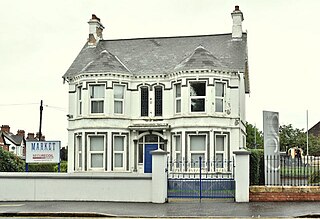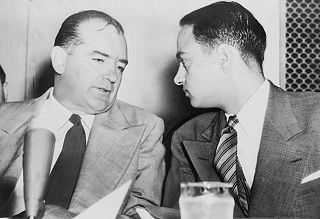Related Research Articles

John Edgar Hoover was an American law enforcement administrator who served as the final Director of the Bureau of Investigation (BOI) and the first Director of the Federal Bureau of Investigation (FBI). President Calvin Coolidge first appointed Hoover as director of the BOI, the predecessor to the FBI, in 1924. After 11 years in the post, Hoover became instrumental in founding the FBI in June 1935, where he remained as director for an additional 37 years until his death in May 1972 – serving a total of 48 years leading both the BOI and the FBI and under eight Presidents.

Extortion is the practice of obtaining benefit through coercion. In most jurisdictions it is likely to constitute a criminal offence; the bulk of this article deals with such cases. Robbery is the simplest and most common form of extortion, although making unfounded threats in order to obtain an unfair business advantage is also a form of extortion.

Victim is a 1961 British neo-noir suspense film directed by Basil Dearden and starring Dirk Bogarde and Sylvia Syms. The first British film to explicitly name homosexuality and deal with it sympathetically, it premiered in the UK on 31 August 1961 and in the US the following February.

Black Hand was a type of Italian extortion racket. Originally developed in the eighteenth century, Black Hand extortion was exported to the United States in the later nineteenth century with Italian immigrants.
Ransomware is a type of cryptovirological malware that permanently blocks access to the victim's personal data unless a "ransom" is paid. While some simple ransomware may lock the system without damaging any files, more advanced malware uses a technique called cryptoviral extortion. It encrypts the victim's files, making them inaccessible, and demands a ransom payment to decrypt them. In a properly implemented cryptoviral extortion attack, recovering the files without the decryption key is an intractable problem, and difficult-to-trace digital currencies such as paysafecard or Bitcoin and other cryptocurrencies are used for the ransoms, making tracing and prosecuting the perpetrators difficult.
Edgar Eugene Pearce is a British extortionist and bomber who was convicted of the Mardi Gra bombings, a three-year blackmail and terror campaign in the London area between December 1994 and April 1998.

The Kincora Boys' Home was a boys' home in Belfast, Northern Ireland, United Kingdom, that was the scene of serious organised child sexual abuse. It caused a scandal and led to an attempted cover-up in 1980, with allegations of state collusion.

The Lavender Scare was a moral panic about homosexual people in the United States government which led to their mass dismissal from government service during the mid-20th century. It contributed to and paralleled the anti-communist campaign which is known as McCarthyism and the Second Red Scare. Gay men and lesbians were said to be national security risks and communist sympathizers, which led to the call to remove them from state employment. It was thought that gay people were more susceptible to being manipulated, which could pose a threat to the country. Lesbians were at less risk of persecution than gay men, but some lesbians were interrogated or lost their jobs.
The Pittsburgh crime family, also known as the LaRocca crime family or the Pittsburgh Mafia, was an Italian-American Mafia crime family based in Pittsburgh, Pennsylvania. The LaRocca family is one of the original 26 Mafia families in the United States. The boss and last known "made" member of the family, Thomas "Sonny" Ciancutti, died in 2021.
Marvell Scott is a physician and former journalist.
The FBI files on Elvis Presley consist of records kept by the Federal Bureau of Investigation concerning Elvis Presley. These records consist of 683 pages of copies of letters from members of the public commenting on his performances, newspaper clippings, and documents reporting that Presley was the target of extortion attempts.
Operation Hyacinth was a secret mass operation in Polish People’s Republic carried out by the Citizens' Militia in the years 1985-87. Its purpose was to create national database of all Polish homosexuals and people who were in touch with them, and it resulted in the registration of around 11,000 people.

Sextortion employs non-physical forms of coercion to extort sexual favors from the victim. Sextortion refers to the broad category of sexual exploitation in which abuse of power is the means of coercion, as well as to the category of sexual exploitation in which threatened release of sexual images or information is the means of coercion.
"Blackmail" is the twelfth episode of the twentieth season of the television series Law & Order. It aired on NBC January 15, 2010.

Black Hand extortion was a criminal tactic used by gangsters based in major cities in the United States. In Chicago, Black Hand extortion began around 1900 and had all but faded away by 1970, replaced by the Mafia. The Mafia was initially organized by Johnny Torrio and further organized by Al Capone into the extant Chicago Outfit sometime later. Black Handers in Chicago were mostly Italian men from Calabria and Sicily who would send anonymous extortion notes to their victims emblazoned with a feared old country symbol: the "Black Hand". The Black Hand was a precursor of organized crime, although it is still a tactic practiced by the Mafia and used in organized crime to this day. The Black Hand gangsters of this time period differed from the Mafia by lacking formally structured hierarchies and codes of conduct, and many were essentially one-man operations. Black Hand blackmail was also common in New York, Boston, and New Orleans. Victims would be threatened with being beaten, shot, or have their place of business bombed if they did not pay. Starting around 1909, Black Hand activity was causing difficulties for mob boss Big Jim Colosimo, a former Black Hand gangster and owner of brothels throughout Chicago. Colosimo's life was being threatened with demands for cash to ensure his physical safety. In an effort to fix the problem, he recruited Johnny Torrio, who was a member of New York's Five Points Gang at the time, to come to Chicago. Torrio would later become the famous successor to Big Jim Colosimo and mentor Al Capone as the organized crime ruler of Chicago.

The Tesco bomb campaign was an attempted extortion against British supermarket chain Tesco which started in Bournemouth, England, in August 2000 and led to one of the largest and most secretive operations ever undertaken by Dorset Police. During the campaign, a blackmailer identified by the pseudonym "Sally" sent letters to Tesco stores threatening to harm customers if his demands—for Clubcards, modified so that the holder could withdraw cash from ATMs—were not met.
Joe Isgro is an American former record promoter and a reputed soldier in the Gambino crime family. In the 1980s, Isgro was at the center of investigations into the role of payola in the music industry.
The 2007 Tesco blackmail campaign was an extortion attempt against the British supermarket chain Tesco.

The Pollachi sexual assault case refers to a case of rape and extortion of numerous women by a gang in Pollachi, Coimbatore in the Indian state of Tamil Nadu. The gang would entice women into isolated places after befriending them on social media and sexually assault them and filmed the act. The videos were later used to blackmail the women for sexual favors or money. The gang came into spotlight after the family of a 19-year-old college student who claimed to had been sexually assaulted and blackmailed complained to the police. According to media accounts, at least 200 women are sexually assaulted in the very same manner and the victims were college and school teachers, doctors, higher secondary school students from all over the state. On the mobiles of the accused, police said they discovered dozens of video recordings of women being abused at a farmhouse belonging to one of the accused and some were leaked.
The Pedigree Chum dog food and Heinz extortion campaign was an attempted extortion against Pedigree Petfoods and Heinz, during which an extortionist contaminated tins of dog and baby food. Pedigree was advised by police to pay limited sums of money to the extortionist, while cash machines were put under surveillance. Heinz lost millions in sales and eventually offered a £100,000 reward, which the extortionist attempted to collect. However, he was arrested at the cashpoint, where police discovered the extortionist was former Metropolitan Police Detective Sergeant Rodney Whitchelo.
References
- 1 2 3 William McGowan (July 11, 2012). "The Chickens and the Bulls". Slate. Retrieved 2015-03-19.
- ↑ Inserra, Vincent L. "Police Corruption." C-1 and the Chicago Mob. N.p.: n.p., n.d. N. pag. Print.
- ↑ Robinette, Sandra, ed. "Interview of Former Special Agent of the FBI Paul J. Brana." (n.d.): n. pag. National Law Enforcement Officers Memorial Fund. 30 Mar. 2005. Web. 13 Mar. 2015.